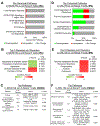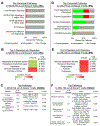Dietary Effects on Dahl Salt-Sensitive Hypertension, Renal Damage, and the T Lymphocyte Transcriptome
- PMID: 31476910
- PMCID: PMC6739138
- DOI: 10.1161/HYPERTENSIONAHA.119.12927
Dietary Effects on Dahl Salt-Sensitive Hypertension, Renal Damage, and the T Lymphocyte Transcriptome
Abstract
The Dahl salt-sensitive (SS) rat is an established model of SS hypertension and renal damage. In addition to salt, other dietary components were shown to be important determinants of hypertension in SS rats. With previous work eliminating the involvement of genetic differences, grain-fed SS rats from Charles River Laboratories (SS/CRL; 5L2F/5L79) were less susceptible to salt-induced hypertension and renal damage compared with purified diet-fed SS rats bred at the Medical College of Wisconsin (SS/MCW; 0.4% NaCl, AIN-76A). With the known role of immunity in hypertension, the present study characterized the immune cells infiltrating SS/MCW and SS/CRL kidneys via flow cytometry and RNA sequencing in T-cells isolated from the blood and kidneys of rats maintained on their respective parental diet or on 3 weeks of high salt (4.0% NaCl, AIN-76A). SS/CRL rats were protected from salt-induced hypertension (116.5±1.2 versus 141.9±14.4 mm Hg), albuminuria (21.7±3.5 versus 162.9±22.2 mg/d), and renal immune cell infiltration compared with SS/MCW. RNA-seq revealed >50% of all annotated genes in the entire transcriptome to be significantly differentially expressed in T-cells isolated from blood versus kidney, regardless of colony or chow. Pathway analysis of significantly differentially expressed genes between low and high salt conditions demonstrated changes related to inflammation in SS/MCW renal T-cells compared with metabolism-related pathways in SS/CRL renal T-cells. These functional and transcriptomic T-cell differences between SS/MCW and SS/CRL show that dietary components in addition to salt may influence immunity and the infiltration of immune cells into the kidney, ultimately impacting susceptibility to salt-induced hypertension and renal damage.
Keywords: albuminuria; diet; flow cytometry; hypertension; transcriptome.
Figures






Similar articles
-
Epigenetic Modifications in T Cells: The Role of DNA Methylation in Salt-Sensitive Hypertension.Hypertension. 2020 Feb;75(2):372-382. doi: 10.1161/HYPERTENSIONAHA.119.13716. Epub 2019 Dec 16. Hypertension. 2020. PMID: 31838911 Free PMC article.
-
Maternal diet during gestation and lactation modifies the severity of salt-induced hypertension and renal injury in Dahl salt-sensitive rats.Hypertension. 2015 Feb;65(2):447-55. doi: 10.1161/HYPERTENSIONAHA.114.04179. Epub 2014 Dec 1. Hypertension. 2015. PMID: 25452472 Free PMC article.
-
Dietary influences on the Dahl SS rat gut microbiota and its effects on salt-sensitive hypertension and renal damage.Acta Physiol (Oxf). 2021 Aug;232(4):e13662. doi: 10.1111/apha.13662. Epub 2021 Apr 26. Acta Physiol (Oxf). 2021. PMID: 33866692 Free PMC article.
-
Role of the adenosine(2A) receptor-epoxyeicosatrienoic acid pathway in the development of salt-sensitive hypertension.Prostaglandins Other Lipid Mediat. 2012 Aug;98(3-4):39-47. doi: 10.1016/j.prostaglandins.2011.12.002. Epub 2011 Dec 22. Prostaglandins Other Lipid Mediat. 2012. PMID: 22227265 Free PMC article. Review.
-
Infiltrating immune cells in the kidney in salt-sensitive hypertension and renal injury.Am J Physiol Renal Physiol. 2014 Sep 1;307(5):F499-508. doi: 10.1152/ajprenal.00258.2014. Epub 2014 Jul 9. Am J Physiol Renal Physiol. 2014. PMID: 25007871 Free PMC article. Review.
Cited by
-
Podocyte cell-specific Npr1 is required for blood pressure and renal homeostasis in male and female mice: role of sex-specific differences.Physiol Genomics. 2024 Oct 1;56(10):672-690. doi: 10.1152/physiolgenomics.00137.2023. Epub 2024 Aug 5. Physiol Genomics. 2024. PMID: 39101921 Free PMC article.
-
Renal Epithelial Mitochondria: Implications for Hypertensive Kidney Disease.Compr Physiol. 2023 Dec 29;14(1):5225-5242. doi: 10.1002/cphy.c220033. Compr Physiol. 2023. PMID: 38158371 Free PMC article.
-
T Cell Immunometabolism and Redox Signaling in Hypertension.Curr Hypertens Rep. 2021 Dec 9;23(12):45. doi: 10.1007/s11906-021-01162-5. Curr Hypertens Rep. 2021. PMID: 34888745 Free PMC article. Review.
-
Impact of bedding on Dahl salt-sensitive hypertension and renal damage.Am J Physiol Renal Physiol. 2022 Dec 1;323(6):F666-F672. doi: 10.1152/ajprenal.00201.2022. Epub 2022 Sep 15. Am J Physiol Renal Physiol. 2022. PMID: 36108053 Free PMC article.
-
Epigenetic Modifications in T Cells: The Role of DNA Methylation in Salt-Sensitive Hypertension.Hypertension. 2020 Feb;75(2):372-382. doi: 10.1161/HYPERTENSIONAHA.119.13716. Epub 2019 Dec 16. Hypertension. 2020. PMID: 31838911 Free PMC article.
References
-
- Benjamin EJ, Virani SS, Callaway CW, Chamberlain AM, Chang AR, Cheng S, Chiuve SE, Cushman M, Delling FN, Deo R, de Ferranti SD, Ferguson JF, Fornage M, Gillespie C, Isasi CR, Jimenez MC, Jordan LC, Judd SE, Lackland D, Lichtman JH, Lisabeth L, Liu S, Longenecker CT, Lutsey PL, Mackey JS, Matchar DB, Matsushita K, Mussolino ME, Nasir K, O'Flaherty M, Palaniappan LP, Pandey A, Pandey DK, Reeves MJ, Ritchey MD, Rodriguez CJ, Roth GA, Rosamond WD, Sampson UKA, Satou GM, Shah SH, Spartano NL, Tirschwell DL, Tsao CW, Voeks JH, Willey JZ, Wilkins JT, Wu JH, Alger HM, Wong SS, Muntner P, American Heart Association Council on E, Prevention Statistics C, Stroke Statistics S. Heart disease and stroke statistics-2018 update: A report from the american heart association. Circulation. 2018;137:e67–e492 - PubMed
-
- Weinberger MH. Salt sensitivity of blood pressure in humans. Hypertension. 1996;27:481–490 - PubMed
-
- Lackland DT, Egan BM. Dietary salt restriction and blood pressure in clinical trials. Curr Hypertens Rep. 2007;9:314–319 - PubMed
-
- Svetkey LP, McKeown SP, Wilson AF. Heritability of salt sensitivity in black americans. Hypertension. 1996;28:854–858 - PubMed
-
- Weinberger MH, Miller JZ, Luft FC, Grim CE, Fineberg NS. Definitions and characteristics of sodium sensitivity and blood pressure resistance. Hypertension. 1986;8:II127–134 - PubMed
Publication types
MeSH terms
Substances
Grants and funding
LinkOut - more resources
Full Text Sources
Medical
Molecular Biology Databases

